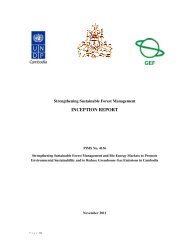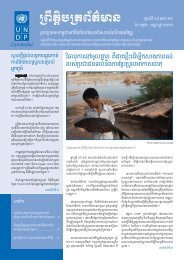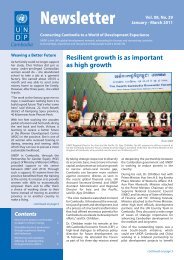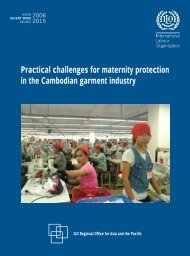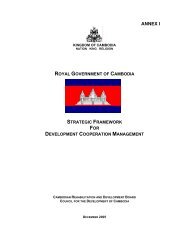UN Analysis Final.pdf - United Nations in Cambodia
UN Analysis Final.pdf - United Nations in Cambodia
UN Analysis Final.pdf - United Nations in Cambodia
You also want an ePaper? Increase the reach of your titles
YUMPU automatically turns print PDFs into web optimized ePapers that Google loves.
BOX 4-5: INTERVENTIONS TO REDUCE GIRLS’ DROP OUT RATE<br />
To address high drop out and illiteracy rates of girls and women, MoWA has focused on non-formal<br />
education, <strong>in</strong>clud<strong>in</strong>g literacy, childcare and vocational tra<strong>in</strong><strong>in</strong>g for women. MoWA also promotes<br />
equal participation by girls and boys <strong>in</strong> primary and secondary schools, and school<strong>in</strong>g for more female<br />
students at all levels. MoWA has worked with MoEYS <strong>in</strong> the development of textbooks, and with MoSVY <strong>in</strong><br />
prepar<strong>in</strong>g tra<strong>in</strong><strong>in</strong>g courses at Women <strong>in</strong> Development Centers, and proposed dormitories for girls.<br />
Source: Education Sector Performance Report 2005<br />
Physical factors: A range of community factors also impact on student retention rates, <strong>in</strong>clud<strong>in</strong>g the<br />
availability of roads, public transport, water, and electricity, which affect the cost of mak<strong>in</strong>g education<br />
accessible to all children.<br />
Physical <strong>in</strong>frastructure <strong>in</strong> the village, <strong>in</strong>clud<strong>in</strong>g schools, pagodas and roads, has been slightly improved<br />
over the past two or three years. Its impact on the improvement of the villagers’ livelihood is doubtful<br />
– Male youth group, Svahoul Village, Siem Reap<br />
No ethnic female young <strong>in</strong> the village has completed secondary level…sometimes they are not able to attend<br />
the class because the school is located far away from home and the road is bad…More girls give up their<br />
school<strong>in</strong>g than boys because the school is far away from home and they fear for their security…we want<br />
more schools built <strong>in</strong> our prov<strong>in</strong>ce – FGD with female youth (age 20-24) Ratanakiri<br />
Quality of education: Discussions with stakeholders and FGD for this study consistently suggested that<br />
the quality of education currently provided falls short of acceptable standards, particularly <strong>in</strong> rural areas such<br />
as Ratanakiri, Banteay Meanchey. Poor quality <strong>in</strong> education results from scarce resources, <strong>in</strong>sufficiently tra<strong>in</strong>ed<br />
teachers and pr<strong>in</strong>cipals, <strong>in</strong>adequate professional development opportunities, and weak local capacity to<br />
take responsibility for school improvements at facility, district and prov<strong>in</strong>cial levels. Teacher quality and<br />
attendance at schools are <strong>in</strong>dispensable elements for student achievement.<br />
We are not angry that the teacher does not come to teach regularly or that they take some money from the<br />
students <strong>in</strong> classes. We always acknowledge that the teacher has a very low salary...how can they live with<br />
this,…it is not enough…the teachers have to travel far, they need to spend on gasol<strong>in</strong>e, and now everyth<strong>in</strong>g<br />
is so expensive…so they have to do this… – FGD with female youth (15-19), Ratanakiri<br />
Expand<strong>in</strong>g access without ensur<strong>in</strong>g m<strong>in</strong>imally adequate quality is a formula for low efficiency <strong>in</strong> education,<br />
which possibly leads to high grade repetition and large numbers of students dropp<strong>in</strong>g out before complet<strong>in</strong>g<br />
basic education (World Bank 2006).<br />
4.2.5 THE LACK OF QUALITY AND ACCESSIBILITY OF EDUCATION PUTS<br />
CAMBODIA AT AN ONGOING DISADVANTAGE<br />
Low retention and high dropout rates <strong>in</strong>crease the vulnerability of young people <strong>in</strong> rural areas and<br />
cont<strong>in</strong>ue to put the nation at a comparable disadvantage. Those who leave school early tend to work for<br />
subsistence-level pay and <strong>in</strong> unskilled jobs. Moreover, they are unlikely to access new work opportunities<br />
that will demand skilled workers <strong>in</strong> either rural and urban areas, as has recently been reported by the MoLVT.<br />
48 Situation <strong>Analysis</strong> of Youth <strong>in</strong> <strong>Cambodia</strong>





